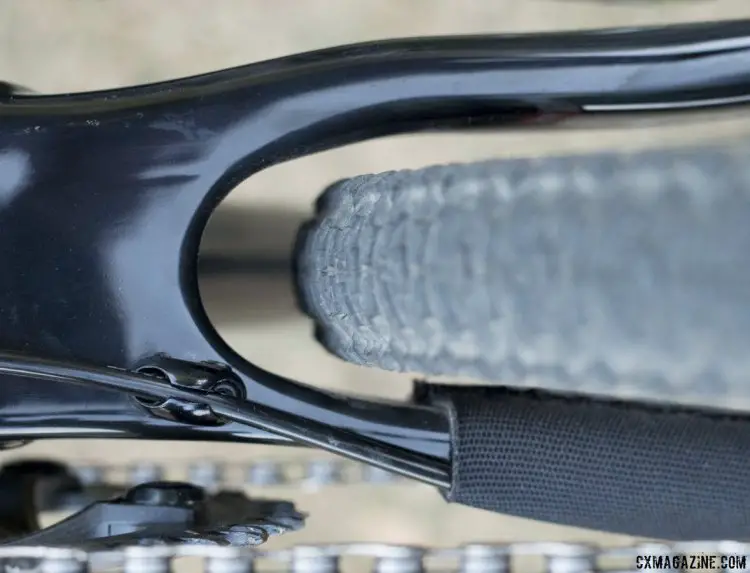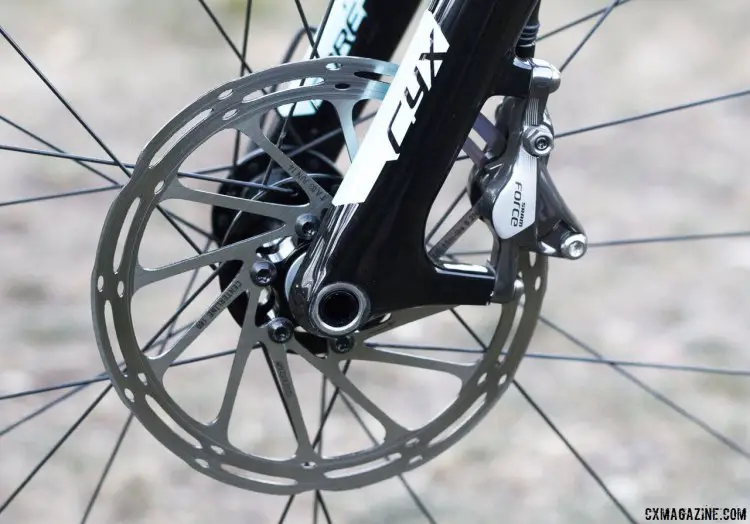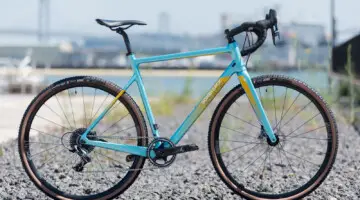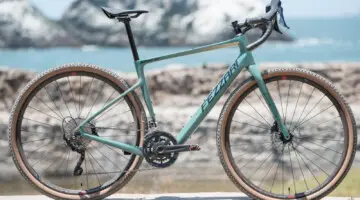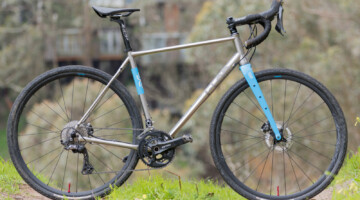THE RIDE:
We put the Cyx to the test right out of the box in local races and weeknight trail rides, and it immediately became a race-day choice for two of us, trading hands more than once before the weekend’s races rolled around.
The front end felt distinctly solid when dropping off of curbs or into chunky sections of terrain, and the steering felt quick and precise, particularly at low speeds. In high-speed road descending, I didn’t feel as confident, perhaps owing to the slightly-higher-than-typical bottom bracket height (6.0cm drop). On the race course, however, the Cyx felt instantly familiar and proved to be a useful partner for our testers, taking two of us to podiums. On our local Wednesday Night Worlds course as well as a rather treacherous Surf City CX race in Santa Cruz, off-camber rooty sections and fast bumpy descents were no problem.
Bottom-bracket stiffness under cornering and acceleration was ideal. Despite the traditional bottom-bracket diameter and width, Fezzari made the most of the carbon construction in this area by placing massive 60mm-tall chainstays at the bottom- bracket junction. Another nice touch is that there’s no mud shelf behind the bottom bracket, with moderate side clearance for the as-equipped 34mm tires on the 24.1mm (outer) NOTUBES Grail rims. The Cyx may not be the ideal monster ’crosser, but it has clearance for muddy races or high-volume tires on dry days.
Speaking of the Stan’s rims, they performed admirably, although we noticed the effects of impacts to the rim while running the tire’s low pressures after only a few weeks of testing. Luckily, with disc rims, the deformation to the rim sidewall is more of an aesthetic issue than a braking performance one, but caution may be warranted when running low pressures and riding inelegantly.
The CX1 group proved unflappable as well, never missing a shift or dropping a chain in our testing. It kept the drivetrain quiet over rough patches and when the bike was put down less-than-smoothly during races. The chain retention actually gave me the confidence to get back on sooner, because the chain wasn’t still bouncing around after touchdown. Although the hood shape and sounds generated by the SRAM brakes took some getting used to, I quickly became accustomed to how easy and consistent it was to feather and modulate the brakes and my speed, and ultimately, to stop. Going back to rim brakes was a bit of a rude awakening.
I selected the 38T front chainring in order to provide a good climbing range for weeknight rides up Northern California’s notoriously steep fire-road grinds, and it turned out to be a good choice. With an easier low gear than a typical compact double with a road cassette (lower than a 36×28), and a high gear that’s big enough for most racing purposes (it was quite limiting for pavement intervals), it might just convert single-ring skeptics such as myself.
Customization in the stock build is another area that we like about Fezzari—for instance, the 5.0 build comes with carbon bars and seatpost, but the buyer could request an alloy cockpit instead. And for racers who already own carbon wheels or want to stick with alloy, there’s no need to pay for the optional carbon Reynolds Assault clinchers.
The tubeless setup as received was serviceable and worked well below 30psi in our tests, although we experienced some air loss over a back-to-back double race on a very bumpy course. The Hutchinson Piranha 2 tires have nice volume in the 34mm size, although we’d be happier if the more-aggressive Toro tread was available with the larger casing.
We’d prefer alloy bars and seatpost over the carbon pieces that came on our test bike, simply for more peace of mind after the inevitable crash. One thing we all agreed on was that the included seatpost isn’t the best choice for CX—a post with an inline two-bolt head to keep the saddle angle locked would be a worthwhile improvement. We’ve learned this lesson again and again and again.
Regardless of the material, I liked the shape of the stock bar quite a bit, and these parts certainly help with the overall weight, which was 17.0 pounds without pedals—quite light for a disc-equipped geared bike with alloy wheels. This wouldn’t be an issue for a prospective buyer, as the entire build is customizable. In fact, at the mid-range of the lineup, Fezzari even offers the choice of 2×11 Shimano or SRAM drivetrains at the same price.
We also applaud the choice of a standard threaded bottom bracket, which is becoming a rarity on carbon frames that feature other “new” tech (like thru-axles and tapered forks). The ability to remove and service an outboard-bearing bottom bracket with basic tools and knowledge is a boon to the home mechanic, and we expect that the setup will remain quieter as time and weather take their toll compared with a similar frame with a PF30 bottom bracket. With the BSA bottom bracket paired with the chain slap-resistant CX1 drivetrain, the Cyx is a silent killer.
THE VERDICT:
It’s hard to find fault with the Foré Cyx, and it’s telling that it was our bike of choice come race day. The rear tire clearance may not be “adventure-ready” and there aren’t rack or fender mounts for repurposing the bike in the off-season, but neither are major concerns for a race-focused bike.
The fit and handling were great, and the parts spec is strong for the price. In addition, the glossy black paint with orange, white and turquoise graphics were hand- some to our eyes, despite veering some- what close to some other brands’ typography. Ordering direct is not for everyone, and certainly does not offer the service and convenience typically found when buying at your local shop. However, if you want a specific build, or are a competent mechanic (or aren’t deterred by the stink-eye of your local shop’s mechanic), Fezzari is ready to meet your needs and help you quietly land on the podium. Don’t tell your competition
FEZZARI FORE CYX SPECS:
MSRP: $3,749 as tested
FRAME: Fezzari Racing Design carbon
FORK: Fezzari Racing Design F5CX-Disc Carbon with 15mm thru-axle, full carbon tapered steerer
WEIGHT: 17.0 pounds, 10.5 pounds with axles, without wheels
SHIFTERS: Force CX1 11-Speed
DERAILLEURS: Force CX1 Type 2 rear, with X-Horizon
CRANKSET: Force CX1
BRAKES: SRAM Force HydroR Calipers
COCKPIT: Fezzari stem, FSA SLK Compact bars
SEATPOST: FSA SLK Carbon Fiber, 31.6mm diameter
SADDLE: WTB Volt Race
WHEELS: NOTUBES Grail Team, Tubeless Ready
TIRES: Hutchison Piranha CX, 700x34C
WARRANTY: Lifetime Limited
COUNTRY OF ORIGIN: Taiwan
MORE INFO: Fezzari.com













